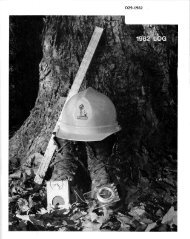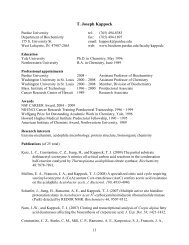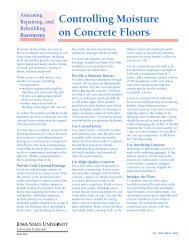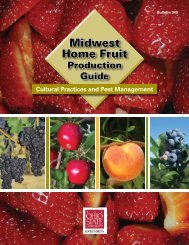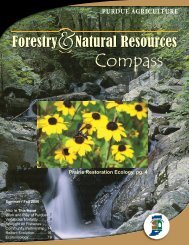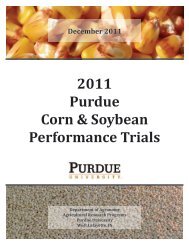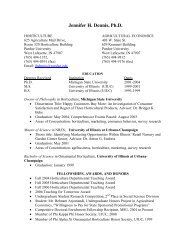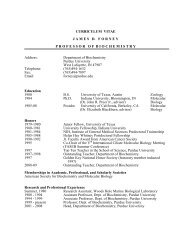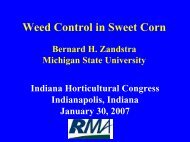potassium guidelines for field crops in new york - Purdue Agriculture
potassium guidelines for field crops in new york - Purdue Agriculture
potassium guidelines for field crops in new york - Purdue Agriculture
Create successful ePaper yourself
Turn your PDF publications into a flip-book with our unique Google optimized e-Paper software.
Potassium Guidel<strong>in</strong>es <strong>for</strong> Field Crops <strong>in</strong> New York. Second Release. June 12, 2003.The pH of these soils ranges from 5.2 to 7.4, but most often the pH is 5.8 orabove. Most subgroup IB soils need some lime <strong>for</strong> alfalfa production. The magnesium(Mg) supply is usually adequate.The organic matter content is generally medium, and the N release is good on thewell-dra<strong>in</strong>ed to moderately well dra<strong>in</strong>ed soils. The N supply<strong>in</strong>g power generally exceeds80 lbs per acre per year, but nitrogen loss is a problem as with the subgroup IA soils.Orig<strong>in</strong>al P levels are low, but the addition of manure and fertilizer P to cultivatedareas may have <strong>in</strong>creased soil P to higher levels. Band placement of P is important <strong>for</strong>crop establishment where P application is recommended. The K supply<strong>in</strong>g power is high,but cont<strong>in</strong>uous cropp<strong>in</strong>g without adequate fertilizer can reduce the K levels.The yield potentials <strong>for</strong> these soils vary from 75 to 120 bushels of corn per acre(13 to 20 tons of silage) depend<strong>in</strong>g on the soil dra<strong>in</strong>age. The potential yields of perennial<strong>for</strong>age range from 2.5 to 5.5 tons per acre (12% moisture), but only the well-dra<strong>in</strong>ed andmoderately well dra<strong>in</strong>ed soils are suited <strong>for</strong> alfalfa production. The Hudson, Odessa, andSchoharie series are examples of the well-dra<strong>in</strong>ed and moderately well dra<strong>in</strong>ed soils ofthe subgroup IB. Other examples are the somewhat poorly and poorly dra<strong>in</strong>ed Caneadea,Canadice, and Rh<strong>in</strong>ebeck soils and the very poorly dra<strong>in</strong>ed Lakemont soils.3.2 Soil management group IIThe soils of this group are medium-textured to moderately f<strong>in</strong>e-textured soilsdeveloped from calcareous glacial till, calcareous glacial till mixed with shale, or recentalluvium. The soils <strong>in</strong> this management group belong to one of three subgroupsdepend<strong>in</strong>g on parent material. Yield potentials of these soils vary from 75 to 150 bushelsof corn (13-26 tons per acre of corn silage) and from 2.5 to 6 tons per acre of <strong>for</strong>age,depend<strong>in</strong>g primarily on the soil dra<strong>in</strong>age characteristics.3.2.1 Subgroup IIAMedium- to f<strong>in</strong>e-textured soils developed from calcareous glacial till. These soilsare found <strong>in</strong> areas of undulat<strong>in</strong>g to gently roll<strong>in</strong>g topography <strong>in</strong> the central pla<strong>in</strong>s of NewYork. They are <strong>for</strong>med from strongly calcareous glacial till. The soil profile is slightlyacid to slightly alkal<strong>in</strong>e <strong>in</strong> the surface and slightly alkal<strong>in</strong>e or strongly alkal<strong>in</strong>e <strong>in</strong> thesubsoil. The surface texture may be a very f<strong>in</strong>e sandy loam, loam, or silt loam with siltloam to silty clay loam subsoils. The water-hold<strong>in</strong>g capacity of these soils is high. Limeis usually not required, but surface soil pH’s are occasionally low. Additions of manureand fertilizer P have <strong>in</strong>creased the P content to high levels <strong>in</strong> some soils.Soil water management is a problem on most of these soils. Erosion control andadequate soil dra<strong>in</strong>age are critical problems. Subsurface dra<strong>in</strong>age is effective <strong>in</strong> remov<strong>in</strong>gexcess soil water. Strip-cropp<strong>in</strong>g, diversion ditches, sod waterways, and subdra<strong>in</strong> outletterraces have successfully provided both erosion control and dra<strong>in</strong>age. Once the watermanagement problems have been solved, these are among the most productive soils ofNew York State.9




